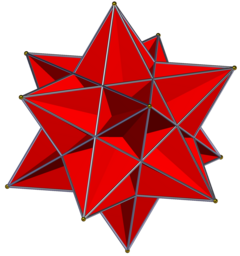
Back Gran icosàedre Catalan Großes Ikosaeder German Granda dudekedro Esperanto Gran icosaedro Spanish Ikosaedro handi Basque بیستوجهی بزرگ Persian Grand icosaèdre French Grande icosaedro Italian 大二十面体 Japanese 큰 이십면체 Korean
| Great icosahedron | |
|---|---|

| |
| Type | Kepler–Poinsot polyhedron |
| Stellation core | icosahedron |
| Elements | F = 20, E = 30 V = 12 (χ = 2) |
| Faces by sides | 20{3} |
| Schläfli symbol | {3,5⁄2} |
| Face configuration | V(53)/2 |
| Wythoff symbol | 5⁄2 | 2 3 |
| Coxeter diagram | |
| Symmetry group | Ih, H3, [5,3], (*532) |
| References | U53, C69, W41 |
| Properties | Regular nonconvex deltahedron |
 (35)/2 (Vertex figure) |
 Great stellated dodecahedron (dual polyhedron) |

In geometry, the great icosahedron is one of four Kepler–Poinsot polyhedra (nonconvex regular polyhedra), with Schläfli symbol {3,5⁄2} and Coxeter-Dynkin diagram of ![]()
![]()
![]()
![]()
![]()
![]()
![]() . It is composed of 20 intersecting triangular faces, having five triangles meeting at each vertex in a pentagrammic sequence.
. It is composed of 20 intersecting triangular faces, having five triangles meeting at each vertex in a pentagrammic sequence.
The great icosahedron can be constructed analogously to the pentagram, its two-dimensional analogue, via the extension of the (n–1)-dimensional simplex faces of the core n-polytope (equilateral triangles for the great icosahedron, and line segments for the pentagram) until the figure regains regular faces. The grand 600-cell can be seen as its four-dimensional analogue using the same process.